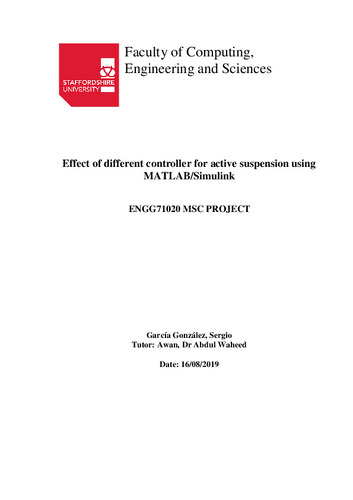Effect of different controller for active suspension using MATLAB/Simulink
Autor(es) y otros:
Director(es):
Palabra(s) clave:
Vehicle Dynamics
Active suspension system
MATLAB
Simulink
Fecha de publicación:
Serie:
Máster Universitario en Ingeniería Mecatrónica
Descripción física:
Resumen:
Active and semi-active suspension systems are very frequently used in the aerospace or civil industry, but they acquire even a greater importance if possible, in the automotive industry. An appropriate control design allows proper control of the vehicle's vibrations, and this is translated into greater driving comfort and superior manoeuvrability. For a controller to function effectively, a model that adequately reproduces the dynamics and kinematics of the suspension must be developed. The purpose of this project is to study and compare various control strategies for active suspensions in commercial cars. In order to achieve this goal, first, the dynamic models that have traditionally been used to assess manoeuvrability and driving comfort are studied, from the quarter model to the full car model. Once the linear dynamic model is developed, complexities such as nonlinearities, or saturations, are added. In the next step, the results obtained for different road types are compared. Finally, using the most appropriate model, different types of control are implemented, and the results compared. It is expected that once the study is completed, a clear conclusion will be obtained on the type of model and controller for active suspensions.
Active and semi-active suspension systems are very frequently used in the aerospace or civil industry, but they acquire even a greater importance if possible, in the automotive industry. An appropriate control design allows proper control of the vehicle's vibrations, and this is translated into greater driving comfort and superior manoeuvrability. For a controller to function effectively, a model that adequately reproduces the dynamics and kinematics of the suspension must be developed. The purpose of this project is to study and compare various control strategies for active suspensions in commercial cars. In order to achieve this goal, first, the dynamic models that have traditionally been used to assess manoeuvrability and driving comfort are studied, from the quarter model to the full car model. Once the linear dynamic model is developed, complexities such as nonlinearities, or saturations, are added. In the next step, the results obtained for different road types are compared. Finally, using the most appropriate model, different types of control are implemented, and the results compared. It is expected that once the study is completed, a clear conclusion will be obtained on the type of model and controller for active suspensions.
Colecciones
- Trabajos Fin de Máster [5290]
Ficheros en el ítem





